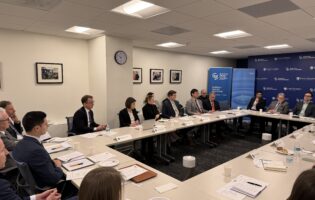Increasing Labor Market Adaptability
On June 23, 2009, the American-German Institute (AGI) sponsored a presentation in Washington, D.C., on “Increasing Labor Market Adaptability Through Lifelong Learning: Institutional Innovation in the United States and Germany?” The talk, presented by Tobias Schulze-Cleven, DAAD/AGI Fellow, was supported by the AGI Society, Culture & Politics Program. Mr. Schulze-Cleven discussed how both Germany and the United States could take cues from Denmark, the world’s leader in continuing education, in terms of how to effectively support lifelong learning in their populations. While not advocating direct institutional transfers, Mr. Schulze-Cleven emphasized that the Danish example highlights the scope of what kind of programs are possible and in which directions institutional innovation in Germany and the U.S. could proceed.
Based on a discussion of the ambiguous definitions of lifelong education programs and their different connotations in various countries, the presentation went over Denmark’s effective approach toward lifelong learning. After describing Denmark’s approach, Mr. Schulze-Cleven analyzed the approaches of Germany and the United States, noting in the process where each country’s system had room for improvement. The proceedings concluded with a discussion of current institutional changes in each country and examining reforms necessary to reach better outcomes in continuing education.
The talk built on research conducted at AGI on cross-national policy learning between Germany and the U.S., as well as on narrower studies conducted by AGI fellows on vocational training or higher education in either country. At the same time, the talk’s focus was significantly wider than some of this research. Going beyond a narrow focus on particular programs and institutions, the presentation focused on the broad question: What educational and training policies could best equip the workforce to navigate the twenty-first century economy?
In Denmark, opportunities for continuing education are available to the entire population, and they are supported by a high share of public funding for both employed and unemployed workers. Denmark’s continuing education policies are part of a welfare regime that provides workers with generous social benefits and companies with a flexible labor market. The combination of these outcomes has prompted researchers and politicians to speak about the country’s “flexi-curity” system. Denmark combines the promotion of labor market flexibility with the guarantee of social security. This amounts to a unique system of “protected mobility” where job mobility levels match those of the United States, but the country’s social safety net is one of Europe’s most effective.
In Germany, workers receive training largely at the beginning of their careers, and continuing education is targeted towards workers who have already attained a high level of education. Additionally, small- and medium-sized companies offer little continuing training for their workforce. Even when workers are granted the rights to further education, few take advantage of it; workers in eleven of the sixteen German states (Länder) possess the rights to five days of continuing education every year, yet only 1.5 percent actually utilize this privilege in part because companies discourage it. Additionally, under the Hartz IV reforms, job training for the long-term unemployed was reduced.
Compared to Germany, the United States has a far more fluid education system, but there are problems with equity. Although 80 percent of students attend public universities, the costs are still staggering; the United States government spends double the OECD average on education and possibly triple the amount spent by Germany. At the same time, 73 percent of the make-up of the U.S. student body is non-traditional, and 40 percent of university students are twenty-five or older. The United States is the only advanced country in which the current generation has a lower level of education than the previous generation because many children of immigrants and children of lower-class parents are both underserved by the U.S. primary and secondary school systems and are excluded by the exorbitant price of higher education.
Within the U.S. labor market, there are many problems, as regulations legislated in the 1930s have never been thoroughly revamped or updated. The Workforce Investment Act (WIA), one of the few policies updated in current times, lost funding a few years ago. Significantly underfunded by the government, it was created to support one-stop career centers. However, few middle-class or skilled white collar workers utilized it. Lastly, in the U.S. only 8 percent of employees belong to unions, which are typically the strongest bastion for demanding furthering education and workers rights; in Denmark, in contrast, 80 percent of workers belong to unions.
What steps should Germany and the United States employ to assist their laborers? In Germany, there must be a strong cultural shift and institutional innovation. In the first place, there will need to be a change in the belief that a worker will stay at the same career and job for the entirety of his work-life. Secondly, continuing education will need to play a stronger role in the country’s vocational and higher education systems. In the United States, the Obama administration is already signaling positive changes. President Obama, for example, urged every American to commit to at least one year of post-high school training. As a sign that the current administration understands that this topic must be studied holistically, the Departments of Labor and Education recently created a joint website addressing this topic. In either country, innovations will build on the institutions that already exist rather than depend on creating wholly new ones.







